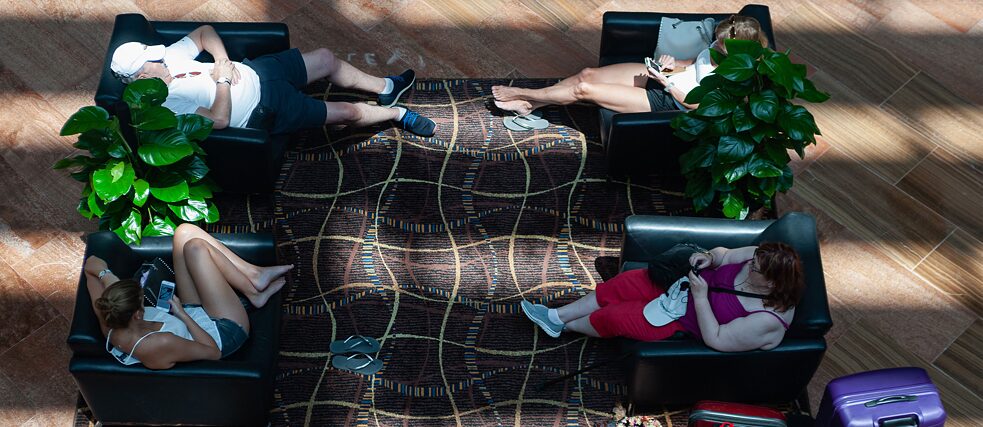Safe(r) Spaces
A Break from the World

Safe(r) Spaces: Many marginalised groups urgently need safe places where they can protect themselves from discrimination and communicate amongst themselves. The term is increasingly entering the discourse because spaces are never completely safe - we can only make them safer.
By Marie Minkov
What does your safe space look like? Mine is my bedroom. It’s two-by-two metres, just big enough for my bed. It’s the cave I sleep in with a window that’s always darkened. No one can see in, no one can see out, and I alone decide who I allow in.
In public places, we don’t have this power to decide. And how safe we feel depends on various factors. I don’t worry about physical threats when I’m out and about; I don’t expect someone to attack me, even though I can’t rule it out. Yet almost everywhere I go as a disabled woman where other people are present, there’s an increased likelihood of verbal confrontations. How often a person encounters these confrontations depends on how they are perceived from the outside, how much their body deviates from the norm defined by society. No one is safe from external perceptions and if they are, then only in very specific spaces.
Safe spaces were originally intended as (physical) shelters for marginalised people. Historically, their origins can be traced to the 1960s, when the queer scene in the US created spaces where queer people could be among themselves. Safe spaces had a similar purpose in the second women’s movement. Spaces were created to which men had no access, which enabled women to express themselves, their desires and goals undisturbed and independent of patriarchal structures.
Today we may encounter safe spaces on festival grounds or at events. Sometimes it’s a darkened room with sofas where people can withdraw. Sometimes it’s a room in a university where students can get supervised support, speak their minds and talk about techniques for dealing with discrimination. Anyone present within these spaces is supposed to be protected from verbal abuse. They’re supposed to find a place to take a break from everyday attributions. For example, if only people with disabilities have access to a space, then there are basic notions of bodies, of norms, of abilities in that space that are very different from the basic notions outside the space. Those present in the room are (theoretically) not in a power imbalance with each other because they are all (theoretically) affected by the same form of discrimination – in this case, ableism.
In practice, this isn’t so easy, because those involved have also internalised structures of discrimination. Sometimes when I’m in safe spaces for people with disabilities, I get the feeling that we’re comparing ourselves, assigning ourselves greater or lesser value based on the disabilities of others (“I’m disabled, but at least I’m not that disabled”). This is because we’ve firmly internalised the idea that the non-disabled body is the better body. We measure ourselves by the power structures we’ve learned in the “outside,” even when it’s “just us.” Nor, for example, does a safe space for people with disabilities mean that queer people or people of colour are protected. Just because someone knows what it’s like to experience queer hostility doesn’t make them immune to racist ways of thinking. Because of this, in many circles the term safe space has a lower case ‘r’ added to it: safer space. We can’t make places safe, only safer.
In the media, the concept of safe(r) spaces has been repeatedly criticised in recent years. There are claims that in university contexts, they might violate academic freedom and merely ensure that students can escape from opinions that contradict their own. Again and again, in arguments against safe spaces we read of a “victim culture” claiming that marginalised people make themselves victims unable to bear “a few unpleasant words.” It’s also been argued that safe spaces only further isolate marginalised people; that separating social groups obstructs real inclusion and that it would make more sense to discuss such issues not in safe spaces, but in the wider society so that everyone can benefit. After all, society can only change if we work with it, not if we “hide” from it.
For me, however, safe(r) spaces are more an attempt at taking a break than at hiding. Discrimination is not an opinion that we encounter now and then and close our eyes to. It’s a power system that we find ourselves in all the time; that we cannot escape. On top of that, almost all the people I know who suffer multiple types of discrimination do some form of civic education work: They constantly engage in dialogue, be it in conversations with strangers on the street. They do the opposite of hiding from the opinions of others. But these confrontations require a great deal of effort. Just as there are moments when we enter into dialogue, there must be moments when we are allowed time out from it.
It's true that the place where I feel safest is my own little bedroom, where I’m all alone, where no one can observe me. That’s the reason many marginalised people isolate themselves: When you’re alone, no one can hurt you. But can we blame people for protecting themselves from experiences of discrimination? Shouldn’t we ask ourselves instead how we can make spaces safer? On a small scale, we create these spaces for ourselves by finding friends who are sensitive enough to discrimination to minimise attributions. On a larger scale, safer spaces are at least an attempt to make the everyday lives of marginalised people a little easier.